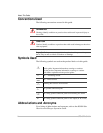
Safety
viii 975-0171-01-01
7. Remove personal metal items such as rings, bracelets, necklaces, and
watches when working with a lead-acid battery. A lead-acid battery
can produce a short-circuit current high enough to weld a ring or the
like to metal, causing a severe burn.
8. Never charge a frozen battery.
9. If it is necessary to remove a battery, always remove the grounded
terminal from the battery first. Make sure all the accessories are off,
so as not to cause an arc.
10. Be sure the area around the battery is well ventilated.
11. Clean the battery terminals. Be careful to keep corrosion from coming
in contact with your eyes.
12. Study all battery manufacturer’s specific precautions such as
removing or not removing the cell caps while charging and the
recommended rates of charge.
13. For refillable (flooded) batteries, add distilled water in each cell until
the battery acid reaches the level specified by the battery
manufacturer. This helps to purge excessive gas from cells. Do not
overfill. Carefully follow the manufacturer’s recharging instructions.
FCC Information to the User
This equipment has been tested and found to comply with the limits for a
Class B digital device, pursuant to part 15 of the FCC Rules. These limits
are designed to provide reasonable protection against harmful
interference when the equipment is operated in a residential environment.
This equipment generates, uses and can radiate radio frequency energy
and, if not installed and used in accordance with the instruction guide,
may cause harmful interference to radio communications. However, there
is no guarantee that interference will not occur in a particular installation.
If this equipment does cause harmful interference to radio or television
reception, which can be determined by turning the equipment off and on,
the user is encouraged to try to correct the interference by one or more of
the following measures:
• Reorient or relocate the receiving antenna.
• Increase the separation between the equipment and the receiver.
• Connect the equipment into an outlet on a circuit different from that
to which the receiver is connected.
• Consult the dealer or an experienced radio/TV technician for help.


















